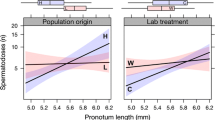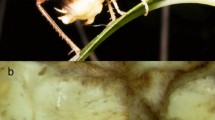Abstract
Nysius huttoni White is a polygamous bug, endemic to New Zealand, and an important pest of wheat and brassicas. This bug has a female-biased sexual size dimorphism but relative to body length, males have longer antennae, suggesting that the allometric scales of antennal–body relationships may be highly selective in sexual selection. Body weight and most morphometric traits measured have no effect on mating success of either sex. Males significantly preferred mating with females having thicker abdomens, more mature eggs, and longer ovipositors. This result suggests that males may select their mates on the basis of immediate reproductive benefit: fertilizing more eggs and ensuring better survival of these eggs. Males with large genital structures have mating advantages over those with small ones, suggesting that precopulation sexual selection in this species act on male genital traits rather than body weight and nonsexual traits. Finally, females significantly preferred males with greater slopes for the antennal-body relationship for mating. The allometry in the male antennal length may be an indicator of male reproductive fitness.
Similar content being viewed by others
REFERENCES
Andersson, M. (1994). Sexual Selection, Princeton University Press, New Jersey.
Arnqvist, G. (1998). Comparative evidence for the evolution of genitalia by sexual selection. Nature 393: 784–786.
Arnqvist, G., and Danielsson, I. (1999). Copulatory behavior, genital morphology, and male fertilization success in water striders. Evolution 53: 147–156.
Arnqvist, G., Thornhill, R., and Rowe, L. (1997). Evolution of animal genitalia: Morphological correlates of fitness components in a water strider. J. Evol. Biol. 10: 613–640.
Birtles, D. B., Waddell, B. C., and Maindonald, J. H. (1992). Mortality responses of Nysius huttoni to a dry-heat disinfestation treatment for apples. Proc. N. Z. Plant Prot. Conf. 45: 269–273.
Boake, C. R. B., Shelly, T. E., and Kaneshiro, K. Y. (1996). Sexual selection in relation to pest-management strategies. Annu. Rev. Entomol. 41: 211–229.
Bonhag, P. F., and Wick, J. R. (1953). The functional anatomy of the male and female reproductive systems of the milkweed bug, Oncopeltus fasciatus (Dallas) (Heteroptera: Lygaeidae). J. Morphol. 93: 177–283.
Capone, T. A. (1995). Mutual preference for large mates in green stink bugs, Acrosternum hilare (Hemiptera: Pentatomidae). Anim. Behav. 49: 1335–1344.
Cordoba-Aguilar, A. (1999). Male copulatory sensory stimulation induces female ejection of rival sperm in a damselfly. Proc. R. Soc. Lond. B 266: 779–784.
Cressey, P. J. (1987). Identification of an insect species causing bug damage in New Zealand wheats. N. Z. J. Agric. Res. 30: 209–212.
Danielsson, I. (2001). Antagonistic pre-and post-copulatory sexual selection on male body size in a water strider (Gerris lacustris). Proc. R. Soc. Lond. 268: 77–81.
Danielsson, I., and Askenmo, C. (1999). Male genital traits and mating interval affect male fertilization success in the water strider Gerris lacustris. Behav. Ecol. Sociobiol. 46: 149–156.
Darwin, C. (1871). TheDescent of Man, and Selection in Relation to Sex, John Murray, London.
Eberhard, W. G. (1998). Sexual behavior of Acanthocephala declivis guatemalana (Hemiptera: Coreidae) and the allometric scaling of their modified hind legs. Ann. Entomol. Soc. Am. 91: 863–871.
Eberhard, W. G. (2004). Male-female conflict and genitalia: Failure to confirm predictions in insects and spiders. Biol. Rev. 79: 121–186.
Eyles, A. C. (1960). Variation in the adult and immature stages of Nysius huttoni White (Heteroptera: Lygaeidae) with a note on the validity of the genus Brachynysius Usinger. Trans. R. Entomol. Soc. Lond. 4: 53–72.
Eyles, A. C. (1963). Fecundity and oviposition rhythms in Nysius huttoni White (Heteroptera: Lygaeidae). N. Z. J. Sci. 6: 186–207.
Eyles, A. C. (1965a). Damage to cultivated Cruciferae by Nysius huttoni White (Heteroptera: Lygaeidae). N. Z. Agric. Res. 8: 494–502.
Eyles, A. C. (1965b). Notes on the ecology of Nysius huttoni White (Heteroptera: Lygaeidae). N. Z. J. Sci. 8: 363–366.
Eyles, A. C., and Ashlock, P. D. (1969). The genus Nysius in New Zealand (Heteroptera: Lygaeidae). N. Z. J. Sci. 12: 713–727.
Ferguson, C. M. (1994). Nysius huttoni White (Heteroptera: Lygaeidae): A pest of direct rilled brassicas. Proc. N. Z. Plant Prot. Conf. 47: 196–197.
Ferguson, I. M., and Fairbairn, D. J. (2000). Sex-specific selection and sexual size dimorphism in the waterstrider Aquarius remigis. J. Evol. Biol. 13: 160–170.
Gurr, L. (1957). Observations on the distribution, life history, and economic importance of Nysius huttoni (Lygaeidae: Hemiptera). N. Z. J. Sci. Technol. 6: 710–714.
He, X. Z., Wang, Q., and Carpenter, A. (2002). Effect of food supply on development, survival, body weight and reproduction of Nysius huttoni White (Heteroptera: Lygaeidae). N. Z. Entomol. 25: 35–40.
Honěk, A. (2003). Body size and mating success in Pyrrhocoris apterus (Heteroptera). Eur. J. Entomol. 100: 55–60.
House, C. M., and Simmons, L.W. (2003). Genital morphology and fertilization success in the dung beetle Onthophagus taurus: An example of sexually selected male genetalia. Proc. R. Soc. Lond. B: Biol. Sci. 270: 447–455.
Jiménez-Pérez, A., and Wang, Q. (2004). Sexual selection in Cnephasia jactatana (Lepidoptera: Tortricidae) in relation to age, virginity, and body size. Ann. Entomol. Soc. Am. 97: 819–824.
Preziosi, R. F., and Fairbairn, D. J. (1996). Sexual size dimorphism and selection in the wild in the waterstrider Aquarius remigis: Body size, components of body size and male mating success. J. Evol. Biol. 9: 317–336.
Rodriguero, M. S., Vilardi, J. C., Vera, M. T., Cayol, J. P., and Rial, E. (2002). Morphometric traits and sexual selection in medfly (Diptera: Tephritidae) under field cage conditions. Fla. Entomol. 85: 143–149.
SAS Institute. (1996). PROC User's Manual, version 6th edn, SAS Institute, Cary, NC.
Sirot, L. K. (2003). The evolution of insect mating structures through sexual selection. Fla. Entomol. 86: 124–133.
Swallow, W. H., and Cressey, P. J. (1987). Historical overview of Nysius huttoni damage in New Zealand wheats. N. Z. J. Agric. Res. 30: 341–344.
Takami, Y. (2003). Experimental analysis of the effect of genital morphology on insemination success in the ground beetle Carabus insulicola (Coleoptera Carabidae). Ethol. Ecol. Evol. 15: 51–61.
Wang, Q. (2002). Sexual selection of Zorion guttigerum Westwood (Coleoptera: Cerambycidae) in relation to body size and color. J. Insect Behav. 15: 701–713.
Wang, Q., and Zeng, W. Y. (2004). Sexual selection and male aggression of Nadezhdiella cantori (Coleoptera: Cerambycidae: Cerambycinae) in relation to body size. Environ. Entomol. 33: 657–661.
Weigensberg, I., and Fairbairn, D. J. (1996). The sexual arms race and phenotypic correlates of mating success in the water strider, Aquarius remigis (Hemiptera: Gerridae). J. Insect Behav. 9: 307–319.
Author information
Authors and Affiliations
Rights and permissions
About this article
Cite this article
Yang, L., Wang, Q. Precopulation Sexual Selection in Nysius huttoni White (Heteroptera: Lygaeidae) in Relation to Morphometric Traits. Journal of Insect Behavior 17, 695–707 (2004). https://doi.org/10.1023/B:JOIR.0000042550.02623.72
Issue Date:
DOI: https://doi.org/10.1023/B:JOIR.0000042550.02623.72




